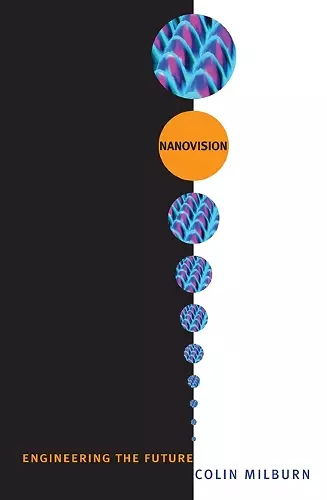Nanovision
Engineering the Future
Format:Hardback
Publisher:Duke University Press
Published:28th Oct '08
Currently unavailable, and unfortunately no date known when it will be back

Examines the cultural history of nanotechnology in contemporary literature, film, and digital media
Trekking across the technoscapes and the dreamscapes of nanotechnology, the author elaborates a theory of nanovision, demonstrating that nanotechnology has depended throughout its history on a symbiotic relationship with science fiction.The dawning era of nanotechnology promises to transform life as we know it. Visionary scientists are engineering materials and devices at the molecular scale that will forever alter the way we think about our technologies, our societies, our bodies, and even reality itself. Colin Milburn argues that the rise of nanotechnology involves a way of seeing that he calls “nanovision.” Trekking across the technoscapes and the dreamscapes of nanotechnology, he elaborates a theory of nanovision, demonstrating that nanotechnology has depended throughout its history on a symbiotic relationship with science fiction. Nanotechnology’s scientific theories, laboratory instruments, and research programs are inextricable from speculative visions, hyperbolic rhetoric, and fictional narratives.
Milburn illuminates the practices of nanotechnology by examining an enormous range of cultural artifacts, including scientific research articles, engineering textbooks, laboratory images, popular science writings, novels, comic books, and blockbuster films. In so doing, he reveals connections between the technologies of visualization that have helped inaugurate nano research, such as the scanning tunneling microscope, and the prescient writings of Robert A. Heinlein, James Blish, and Theodore Sturgeon. He delves into fictive and scientific representations of “gray goo,” the nightmare scenario in which autonomous nanobots rise up in rebellion and wreak havoc on the world. He shows that nanoscience and “splatterpunk” novels share a violent aesthetic of disintegration: the biological body is breached and torn asunder only to be refabricated as an assemblage of self-organizing machines. Whether in high-tech laboratories or science fiction stories, nanovision deconstructs the human subject and galvanizes the invention of a posthuman future.
“A paradox: we see the future utterly transformed by nanotechnology and related technosciences; because the future is transformed, we cannot see it at all. Spiraling out from this central insight, Nanovision explores the cultural and social implications of nanotechnology through a wide range of material-semiotic-discursive effects. Witty, incisive, and insightful, Nanovision is essential reading for anyone interested in where we are now and where we might be headed.”—N. Katherine Hayles, Duke University
“There has been so much hype and controversy surrounding nanotech that it has been hard to figure out what it really is or might become. This wonderful book spectacularly clarifies matters, providing the new field with its history and with a paradigm that allows us to judge its present situation and whatever future may emerge. That Colin Milburn is also often wickedly funny is much appreciated, and a very appropriate response to nanotech’s constant evocations of paradise or apocalypse.”—Kim Stanley Robinson, author of the Mars Trilogy
ISBN: 9780822342434
Dimensions: unknown
Weight: 562g
296 pages